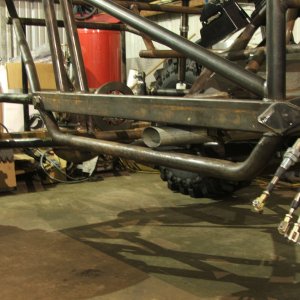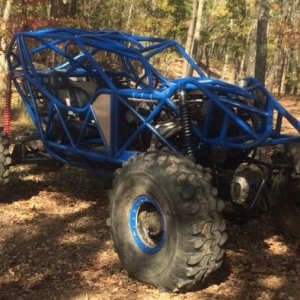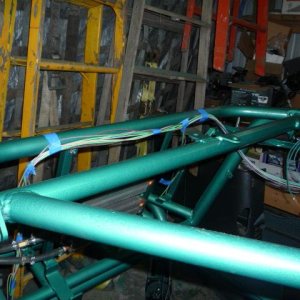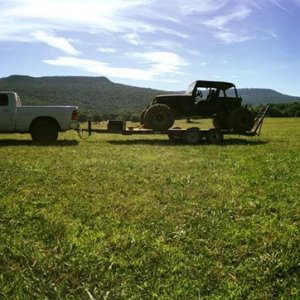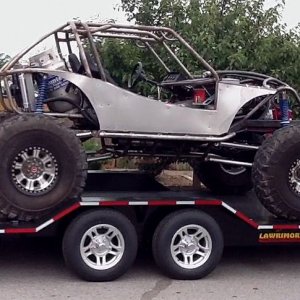Ok guys im wanting opinions, i just got offered a good deal on a pair of air shocks for my rig. Iv been looking hard at coil overs till this come up so im really wanting input on these shocks if there good to run or have problems let me here it all good, bad or indefernt.
-
Help Support Hardline Crawlers :
You are using an out of date browser. It may not display this or other websites correctly.
You should upgrade or use an alternative browser.
You should upgrade or use an alternative browser.
AIR SHOCKS INSTEAD OF COIL OVERS???? YES OR NO
- Thread starter jfwelding
- Start date
Mortalis5509
Well-Known Member
coilovers
infamous1
Well-Known Member
Re:
I have 2.0 Fox air shox and am going to coils as soon as budget allows, I have had three failures from the front shocks due to really hard impact breaking eyelet off the shaft (possible overextension) and breaking Schrader valves off. Kinda leaves you dead in the water when you loose your nitrogen charge.
Sent from my Z750C using Tapatalk
I have 2.0 Fox air shox and am going to coils as soon as budget allows, I have had three failures from the front shocks due to really hard impact breaking eyelet off the shaft (possible overextension) and breaking Schrader valves off. Kinda leaves you dead in the water when you loose your nitrogen charge.
Sent from my Z750C using Tapatalk
Stuntman Autoworks
Well-Known Member
Re:
To be fair one schrader broke off because a tree fell on it, lol
Go coilovers if you can I run co in the front and airshocks in the back of mine right now but once I can afford em coilovers will be going in the rear also.
infamous1 said:I have 2.0 Fox air shox and am going to coils as soon as budget allows, I have had three failures from the front shocks due to really hard impact breaking eyelet off the shaft (possible overextension) and breaking Schrader valves off. Kinda leaves you dead in the water when you loose your nitrogen charge.
Sent from my Z750C using Tapatalk
To be fair one schrader broke off because a tree fell on it, lol
Go coilovers if you can I run co in the front and airshocks in the back of mine right now but once I can afford em coilovers will be going in the rear also.
nhl_bullitt
Southern IL/MO
We don't know much about your rig but I would only consider the air shocks if they are 2.5. To me air shocks have an appealing convenience about them, but a properly set up coilover should perform better, especially in "go - fast" situations. FWIW, I have 2.5 air shocks at each corner.
im just asking a general comparison question as in good or bad, run the air shocks or no go coil overs and yes the air shocks are 2.5's.
Whats been the issue with eveyone wanting to switch from air shocks to coil overs like what fails have happened ?
Whats been the issue with eveyone wanting to switch from air shocks to coil overs like what fails have happened ?
Chilkat
Active Member
- Joined
- May 5, 2014
- Messages
- 25
Airshox are more trial and error than coilovers to get the ride height and spring rate desired as it depends on valving and amount of oil and nitrogen. Air shox also "unload" or push back more than coilovers. Coilovers you calculate the springs you need and adjust ride height with the spanner nuts. There is a lot more to it than that, but that is the general idea.
'
'
Re:
Same thing can happen to a CO. That's more lack of bump/strap/protection.
infamous1 said:I have 2.0 Fox air shox and am going to coils as soon as budget allows, I have had three failures from the front shocks due to really hard impact breaking eyelet off the shaft (possible overextension) and breaking Schrader valves off. Kinda leaves you dead in the water when you loose your nitrogen charge.
Sent from my Z750C using Tapatalk
Same thing can happen to a CO. That's more lack of bump/strap/protection.
infamous1
Well-Known Member
Re: Re: Re:
Sent from my Z750C using Tapatalk
yeah I admitted that but the straps didn't help from breaking the schraders off. At least with coils you can still ride if you break a schrader valve, I just think I can get my front axle to plant better and not push off as bad with c/o's. Now as soon as my bonus arrives I am gonna see......mikeyg79 said:Same thing can happen to a CO. That's more lack of bump/strap/protection.
Sent from my Z750C using Tapatalk
untchabl
On the Rocks
I've got 14" 2.0 air shocks on all 4 corners of my transaxle buggy with an anti-rock sway bar on the rear. I'm honestly very happy with how my buggy handles. The shocks don't really unload and it feels very stable. I have no clue on the oil weight, nitrogen pressure, etc since the PO set up everything.
On the other hand, I've got a buddy with 2.0 air shocks on his rig and it can just about flop on flat ground turning in the parking lot. Lol. Setup has a lot to do with how they perform.
On the other hand, I've got a buddy with 2.0 air shocks on his rig and it can just about flop on flat ground turning in the parking lot. Lol. Setup has a lot to do with how they perform.
untchabl said:I've got 14" 2.0 air shocks on all 4 corners of my transaxle buggy with an anti-rock sway bar on the rear. I'm honestly very happy with how my buggy handles. The shocks don't really unload and it feels very stable. I have no clue on the oil weight, nitrogen pressure, etc since the PO set up everything.
On the other hand, I've got a buddy with 2.0 air shocks on his rig and it can just about flop on flat ground turning in the parking lot. Lol. Setup has a lot to do with how they perform.
this right here i beleave really says it all....... " Setup has a lot to do with how they perform "
clemsonjeep
Well-Known Member
Yep...keep your uppers and lowers as parallel to the ground as possible...with as little shock shaft showing as possible. Center of gravity also plays a huge part in the way the air shocks will react. With a higher CoG they WILL exhibit the "jacking" that people associate with them...they will want to push the truck to one side...whichever side it wants to naturally lean to.
I know this isn't necessarily a suspension geometry thread, but all of this applies...here's a quote from Jesse Haines that I really though laid it out there...
"I've experimented with anti-squat plenty. Too much AS causes the suspension to stiffen when torque is applied. On a climb with a rock or ledge that contacts the rear tires, the suspension is too rigid to absorb the obstacle that it contacts, resulting in a bounce or hop. A car with low AS can smoothly spin the rear tires as it goes up a flat climb. A car with high AS will start to hop. If the AS is too low, it won't assist in supporting the car when weight is transferred."
He also brought up weight placement...
"To add to the weight balance thing a little more, imagine trying to push a sled uphill. It's more stable with the weight at the rear. The same applies if you're pushing it down a hill. If the car's overall bias is rear heavy it can't pull itself over obstacles. Another critical component is weight transfer. We're constantly climbing in these cars. The steeper the angle, the more weight that is transferred to the rear. If the rear of the car is light, the shocks can't handle the added weight. If you adjust the shocks to handle the added weight then they are too stiff on flat ground and unloading badly on downhills. If the rear sprung weight is the majority of the chassis weight, the suspension won't become overloaded when weight is transferred on climbs."
I know this isn't necessarily a suspension geometry thread, but all of this applies...here's a quote from Jesse Haines that I really though laid it out there...
"I've experimented with anti-squat plenty. Too much AS causes the suspension to stiffen when torque is applied. On a climb with a rock or ledge that contacts the rear tires, the suspension is too rigid to absorb the obstacle that it contacts, resulting in a bounce or hop. A car with low AS can smoothly spin the rear tires as it goes up a flat climb. A car with high AS will start to hop. If the AS is too low, it won't assist in supporting the car when weight is transferred."
He also brought up weight placement...
"To add to the weight balance thing a little more, imagine trying to push a sled uphill. It's more stable with the weight at the rear. The same applies if you're pushing it down a hill. If the car's overall bias is rear heavy it can't pull itself over obstacles. Another critical component is weight transfer. We're constantly climbing in these cars. The steeper the angle, the more weight that is transferred to the rear. If the rear of the car is light, the shocks can't handle the added weight. If you adjust the shocks to handle the added weight then they are too stiff on flat ground and unloading badly on downhills. If the rear sprung weight is the majority of the chassis weight, the suspension won't become overloaded when weight is transferred on climbs."
Chilkat
Active Member
- Joined
- May 5, 2014
- Messages
- 25
Jesse Haines has a lot of good knowledge through experience, good stuff right there.
I think the setup is the most important thing with the air shocks, you can get them to work very well. Keep the nitrogen charge low and they will unload less simply because there is less positive pressure in the shock.
I'm currently tuning some fox 2.0 air shocks and have been doing a lot of research on the subject. First I tried a 105 psi nitrogen charge and used 5w shock oil to adjust the ride height. I started at 350 cc and went from there. However to get the 6" of shaft ride height I was looking for I hydro-locked the shocks with somewhere around 450cc of oil. I then went back to 350cc with 150 psi nitrogen and ended up with 3" or so of shaft. I added some oil about 25cc total and charged the shocks to about 190 psi and have about 4.5" of shaft showing and they seem to soak up the bumps, I am doing some testing this weekend to see how well they do on the off camber portions of the trail I'm running.
That is an example of what it has taken me to get the shocks set up good enough. I hope that helps.
I think the setup is the most important thing with the air shocks, you can get them to work very well. Keep the nitrogen charge low and they will unload less simply because there is less positive pressure in the shock.
I'm currently tuning some fox 2.0 air shocks and have been doing a lot of research on the subject. First I tried a 105 psi nitrogen charge and used 5w shock oil to adjust the ride height. I started at 350 cc and went from there. However to get the 6" of shaft ride height I was looking for I hydro-locked the shocks with somewhere around 450cc of oil. I then went back to 350cc with 150 psi nitrogen and ended up with 3" or so of shaft. I added some oil about 25cc total and charged the shocks to about 190 psi and have about 4.5" of shaft showing and they seem to soak up the bumps, I am doing some testing this weekend to see how well they do on the off camber portions of the trail I'm running.
That is an example of what it has taken me to get the shocks set up good enough. I hope that helps.

